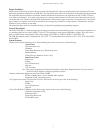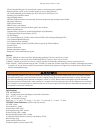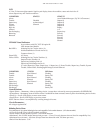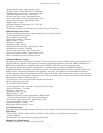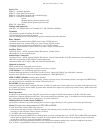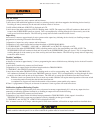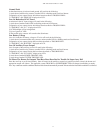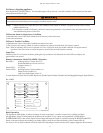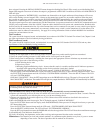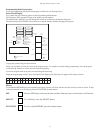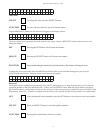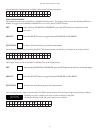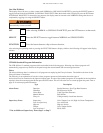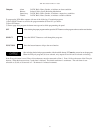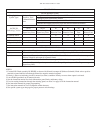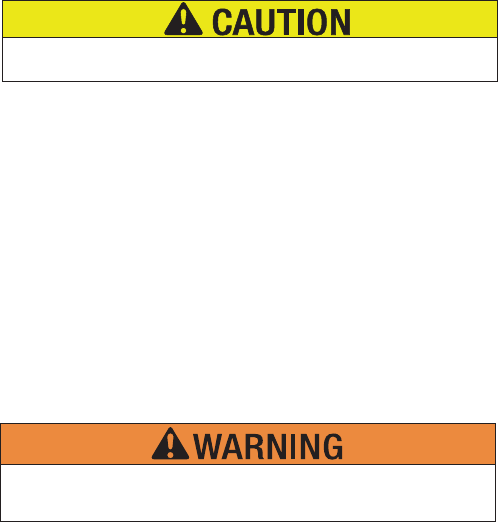
13
VFR-400 • 5403548 • REV D • 10/07
have activated. Pressing the SIGNAL SILENCE button changes the fl ashing Red Zone LED to steady on and the fl ashing Red
Output LED mapped to that zone off unless the output is programmed as RELEASE. In addition, the Yellow ALARM/ SILENCE
LED will light.
Any zone programmed as WATERFLOW is considered non-silenceable so the signal and buzzer silence buttons will have no
effect on the fl ashing zone and output LED's. A buzzer on the annunciator sounds for any trouble condition. When the panel
has a trouble or supervisory condition, pressing the SILENCE/LAMP TEST button silences the condition at the panel and all
annunciators. When the panel is in a normal state, pressing the SILENCE/LAMP TEST button can be used to test the LED's.
The release panel supervises and communicates with the annunciator via separate connections for the RS-485 communication and
24VDC power requirements of the RA-4410-RC. Separate cables should be used for power and communication. Shielded cable
shall be used for the communication line. Up to three annunciators can be connected to one panel. A rotary switch is provided on
the panel to indicate how many annunciators are connected. Another rotary switch is on the annunciator to set the address. The
annunciators must be addressed consecutively. See page 54 for wiring information. Refer to bulletin #8840024 for installation
instructions and maximum wire run.
Test Procedure
The system should be inspected, tested, and maintained in accordance with NFPA-72 National Fire Alarm Code, Chapter 10 and
any other requirements of the local authority having jurisdiction.
Test Procedure (Canada)
The system should be inspected, tested, and maintained in accordance with ULC Standard CAN/ULC-S536 and any other
requirements of the local authority having jurisdiction.
1) Notify the fi re department or other receiving station if alarm, supervisory and/or trouble signals are transmitted.
2) Notify the proper building personnel so that audible and/or visual signals can be ignored.
3) If the release panel is monitored by a building fi re alarm panel, take appropriate action to eliminate any unwanted events.
4) Momentarily open each of the following circuits.
a) Each initiating device zone
b) Supervisory circuit
c) Indicating Appliance/Releasing circuit - observe that this results in a trouble condition and all indicators operate as
described in the appropriate preceding section for the particular circuit that is faulted.
5) Move the PROGRAM switch down. The LCD should respond: “LOOK AT HISTORY?”. Press the FUNCTION button
until the display reads PASSWORD=000. Enter password if changed from factoy or press the SET button three times. Press
the FUNCTION (bottom) button until the LCD reads “SYSTEM MODE: NORMAL”. Press the SELECT button. The LCD
will read “SYSTEM MODE:
ONE MAN WALKTEST”. Press the SET button then move the PROGRAM switch up. The panel will respond with “ONE
MAN WALKTEST” and the time. The trouble LED will light. Any output described as “RELEASING” will automatically be disabled.
After 30 minutes of no activity in the walk test mode the panel automatically reverts to normal operation.
6) Operate each initiating device on all zones. All audible and visual alarm devices should operate for about 3 seconds. Then the
system will automatically reset allowing the user to go to the next initiating device.
7) Operate each initiating device on the supervisory circuit. Observe that all the indications described in the section on
supervisory conditions occur.
8) Move the PROGRAM switch down again. The LCD should respond: “LOOK AT HISTORY?”
Press the FUNCTION button until the display reads PASSWORD=000. Enter password if changed from factory or press the
SET button three times.
Press the FUNCTION (bottom) button until the LCD reads: “SYSTEM MODE: ONE MAN WALKTEST”
Press the SELECT (middle) button. The LCD will read: “SYSTEM MODE: NORMAL”
Press the SET (top) button then restore the PROGRAM switch to the up position. The LCD will show the normal banner message.
9) All audible and visual indicators should be off.
10) Notify all building, fi re department, and/or other receiving station personnel that the test has concluded.
Maintenance: Test batteries per local and national standards. At a minimum replace batteries every four (4) years or sooner
depending on test results. The date of purchase shall be marked on all batteries.
Testing should be done as a minimum as described below:
Failure to enter the walktest mode and subsequent operation
of initiating zones may result in a release.



